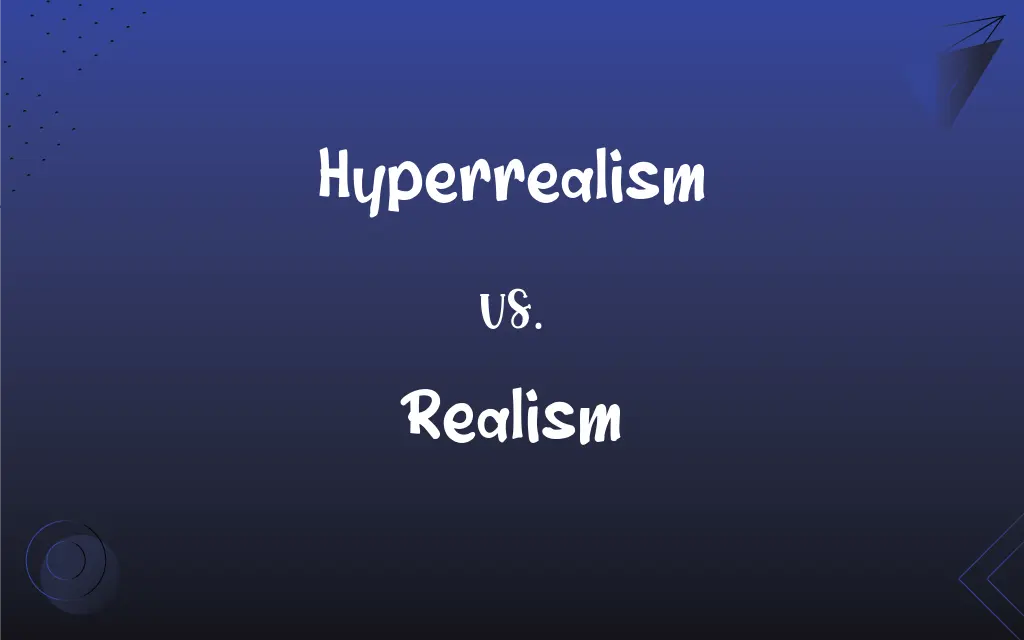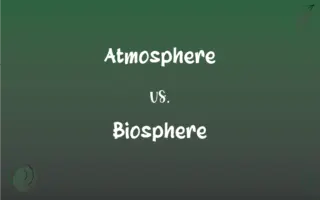Hyperrealism vs. Realism: What's the Difference?
By Aimie Carlson || Updated on May 24, 2024
Hyperrealism is an art movement that creates artworks resembling high-resolution photographs, while realism focuses on depicting subjects accurately and truthfully, often with a focus on everyday life.

Key Differences
Hyperrealism is an art form where the artwork resembles a high-resolution photograph, aiming for extreme detail and lifelike precision. It often involves techniques that make the viewer question whether the piece is a photograph or a painting. Realism, on the other hand, strives to depict subjects truthfully and accurately, often focusing on ordinary, everyday scenes without idealization or abstraction.
Hyperrealism tends to emphasize minute details and textures, pushing the boundaries of visual accuracy to create an almost surreal clarity. Realism focuses on a more general representation of subjects, capturing their essence and authenticity without necessarily delving into hyper-detailed precision.
Hyperrealism often uses modern tools and techniques such as airbrushing and digital aids to achieve its highly detailed results. Realism traditionally relies on more classical methods, emphasizing accurate proportion, light, and color to portray subjects faithfully.
Hyperrealism can sometimes create an almost clinical or mechanical feel due to its emphasis on perfection and detail. Realism, by contrast, often seeks to evoke emotion and social commentary through its truthful representation of life and nature.
Comparison Chart
Definition
Art resembling high-resolution photos
Art depicting subjects truthfully and accurately
ADVERTISEMENT
Focus
Extreme detail and lifelike precision
Everyday scenes and truthful representation
Techniques
Modern tools like airbrushing, digital aids
Classical methods emphasizing proportion, light, and color
Visual Style
Almost surreal clarity and detail
Authentic and straightforward portrayal
Emotional Impact
Can appear clinical or mechanical
Often evokes emotion and social commentary
Hyperrealism and Realism Definitions
Hyperrealism
Style mimicking high-resolution photos.
His hyperrealism art captures every wrinkle and pore.
ADVERTISEMENT
Realism
Art movement depicting subjects truthfully.
Realism art portrays life without idealization.
Hyperrealism
Art movement focusing on creating extremely detailed works.
The hyperrealism painting looked like a photograph.
Realism
Art reflecting social and emotional truths.
Realism often addresses social issues through its honest depictions.
Hyperrealism
Art creating a surreal, detailed clarity.
The hyperrealism sculpture seemed almost too real to be true.
Realism
Style emphasizing accuracy and authenticity.
Realism aims to show things as they are.
Hyperrealism
Technique emphasizing lifelike precision.
Hyperrealism artists spend hours perfecting small details.
Realism
Focus on ordinary, everyday scenes.
His realism paintings capture daily rural life.
Hyperrealism
Use of modern tools for precision.
She used an airbrush to achieve hyperrealism effects.
Realism
Classical techniques for faithful representation.
Realism artists use proportion and light for accuracy.
Hyperrealism
An artistic style characterized by highly realistic graphic representation.
Realism
An inclination toward literal truth and pragmatism.
Hyperrealism
A style in art that attempts to reproduce highly realistic graphic representations
Realism
The representation in art or literature of objects, actions, or social conditions as they actually are, without idealization or presentation in abstract form.
Hyperrealism
(music) A compositional style defined by Noah Creshevsky as "an electroacoustic musical language constructed from sounds that are found in our shared environment (realism), handled in ways that are somehow exaggerated or excessive (hyper)."
Realism
The scholastic doctrine, opposed to nominalism, that universals exist independently of their being thought.
Realism
The modern philosophical doctrine, opposed to idealism, that objects exist independently of their being perceived.
Realism
A concern for fact or reality and rejection of the impractical and visionary.
Realism
An artistic representation of reality as it is.
Realism
(sciences) The viewpoint that an external reality exists independent of observation.
Realism
(philosophy) A doctrine that universals are real—they exist and are distinct from the particulars that instantiate them.
Realism
As opposed to nominalism, the doctrine that genera and species are real things or entities, existing independently of our conceptions. According to realism the Universal exists ante rem (Plato), or in re (Aristotle).
Realism
Fidelity to nature or to real life; representation without idealization, and making no appeal to the imagination; adherence to the actual fact.
Realism
The practise of assessing facts and the probabilities of the consequences of actions in an objective manner; avoidance of unrealistic or impractical beliefs or efforts. Contrasted to idealism, self-deception, overoptimism, overimaginativeness, or visionariness.
Realism
The attribute of accepting the facts of life and favoring practicality and literal truth
Realism
(philosophy) the philosophical doctrine that physical object continue to exist when not perceived
Realism
The state of being actual or real;
The reality of his situation slowly dawned on him
Realism
An artistic movement in 19th century France; artists and writers strove for detailed realistic and factual description
Realism
(philosophy) the philosophical doctrine that abstract concepts exist independent of their names
FAQs
How does hyperrealism achieve its detailed look?
Hyperrealism uses modern tools and techniques such as airbrushing and digital aids.
Are hyperrealism artworks always paintings?
No, hyperrealism can include sculptures and drawings that achieve a high level of detail.
What is hyperrealism?
Hyperrealism is an art movement that creates artworks resembling high-resolution photographs.
What distinguishes realism from hyperrealism?
Realism emphasizes truthful representation without extreme detail, while hyperrealism focuses on lifelike precision and high detail.
What emotions does hyperrealism typically evoke?
Hyperrealism can evoke awe due to its precision but may also feel clinical or mechanical.
Does realism idealize its subjects?
No, realism aims to depict subjects as they are, without idealization.
Why is realism considered straightforward?
Realism captures the essence of subjects without embellishment, showing things as they are.
What is realism in art?
Realism focuses on depicting subjects accurately and truthfully, often portraying everyday life.
What impact has hyperrealism had on contemporary art?
Hyperrealism has pushed the boundaries of visual accuracy and has influenced various modern art forms.
Can hyperrealism be considered a type of realism?
Yes, hyperrealism is an extension of realism but with an emphasis on extreme detail and lifelike accuracy.
Do hyperrealism artists use photographs as references?
Yes, hyperrealism artists often use photographs to achieve their high level of detail.
What era did realism emerge?
Realism emerged in the mid-19th century as a reaction to romanticism.
Can realism be considered abstract?
No, realism aims to depict subjects as they appear in real life, avoiding abstraction.
Is realism concerned with social commentary?
Yes, realism often addresses social and political issues through its truthful depictions.
How long does it take to create a hyperrealism piece?
Creating a hyperrealism piece can take a significant amount of time due to the detailed work involved.
What techniques are essential in realism?
Realism relies on classical techniques such as accurate proportion, light, and color.
Do hyperrealism and realism share any similarities?
Both aim to depict subjects accurately, but hyperrealism focuses on extreme detail.
Is realism still relevant in today’s art world?
Yes, realism remains a significant and influential style, continuing to inspire artists.
What subjects are commonly depicted in realism?
Realism often depicts everyday life, social issues, and natural scenes.
Is hyperrealism more modern than realism?
Yes, hyperrealism is a more modern movement, utilizing contemporary techniques.
About Author
Written by
Aimie CarlsonAimie Carlson, holding a master's degree in English literature, is a fervent English language enthusiast. She lends her writing talents to Difference Wiki, a prominent website that specializes in comparisons, offering readers insightful analyses that both captivate and inform.
































































